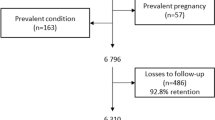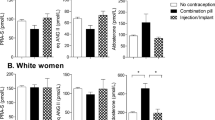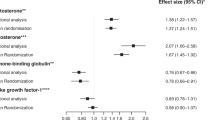Abstract
Oral contraceptives (OC) modulate the risk for developing cardiovascular (CV) diseases. The aim of this study was to determine whether the use of third-generation OC has an impact on markers of CV disease in genetically identical women. We performed an intrapair comparison in 27 monozygotic twin pairs, one of whom was taking third-generation OC, whereas the other was not using OC. Biometric parameters were ascertained and conventional and 24-h ambulatory blood pressure (BP) was recorded. A fasting blood sample was taken for the measurement of glucose, insulin, proinsulin, lipids, and insulin-like growth factor binding protein-1 (IGFBP-1). Insulin resistance and β-cell function were calculated by homeostasis model assessment (HOMA). A 24-h urine sample for cortisol was obtained. Third-generation OC use increased 24-h ambulatory systolic and diastolic BP by 5.2 and 3.9 mmHg, respectively (both P=0.0003). There was no effect on glucose, insulin and proinsulin levels, and on HOMA parameters, but the IGFBP-1 levels were markedly raised (P=0.0009). The lipid profile showed a 34% increase in triglyceride levels (P<0.0001), but also a 7% increase in HDL-cholesterol levels (P=0.037). Use of third-generation OC impacts on CV disease markers in young-adult genetically identical women. Some changes are beneficial (increased HDL-cholesterol), whereas others may be deleterious (increased BP and triglyceride levels) or have unknown effects at this time (increased IGFBP-1 levels).
This is a preview of subscription content, access via your institution
Access options
Subscribe to this journal
Receive 12 digital issues and online access to articles
$119.00 per year
only $9.92 per issue
Buy this article
- Purchase on Springer Link
- Instant access to full article PDF
Prices may be subject to local taxes which are calculated during checkout
Similar content being viewed by others
References
World Health Organization Collaborative Study of Cardiovascular Disease and Steroid Horone Contraception. Venous thromboembolic disease and combined oral contraceptives: results of international multicentre case–control study. Lancet 1995; 346: 1575–1582.
Chasan-Taber L et al. Prospective study of oral contraceptives and hypertension among women in the United States. Circulation 1996; 94: 483–489.
Poulter NR et al. Effect on stroke of different progestagens in low oestrogen dose oral contraceptives. Lancet 1999; 354: 301–302.
Tanis BC et al. Oral contraceptives and the risk of myocardial infarction. N Engl J Med 2001; 345: 1787–1793.
Kemmeren JM, Algra A, Grobbee DE . Third generation oral contraceptives and risk of venous thrombosis: meta-analysis. BMJ 2001; 323: 1–9.
Loos R, Derom C, Vlietinck R, Derom R . The East Flanders Prospective Twin Survey (Belgium): a population-based register. Twin Res 1998; 1: 167–175.
Loos RJ et al. Birth weight and body composition in young women: a prospective twin study. Am J Clin Nutr 2002; 75: 676–682.
Verhaeghe J et al. IGF-I, IGF-II, IGF binding protein 1, and C-peptide in second trimester amniotic fluid are dependent on gestational age but do not predict weight at birth. Pediatr Res 1999; 46: 101–108.
Matthews DR et al. Homeostasis model assessment: insulin resistance and beta-cell function from fasting plasma glucose and insulin concentrations in man. Diabetologia 1985; 28: 412–419.
Avins AL, Neuhaus JM . Do triglycerides provide meaningful information about heart disease risk? Arch Intern Med 2000; 160: 1937–1944.
Yudkin JS et al. Concentrations of proinsulin like molecules predict coronary heart disease risk independently of insulin: prospective data from the Caerphilly Study. Diabetologia 2002; 45: 327–336.
Heald A et al. Close relation of fasting insulin-like growth factor binding protein-1 (IGFBP-1) with glucose tolerance and cardiovascular risk in two populations. Diabetologia 2001; 44: 333–339.
Fuchs N, Düsterberg B, Weber-Diehl F, Mühe B . The effect on blood pressure of a monophasic oral contraceptive containing ethinyloestradiol and gestodene. Contraception 1995; 51: 335–339.
Speroff L, DeCherney A . Evaluation of a new generation of oral contraceptives. Obstet Gynecol 1993; 81: 1034–1047.
Westwood M, Gibson JM, Pennells LA, White A . Modification of plasma insulin-like growth factors and binding proteins during oral contraceptive use and the normal menstrual cycle. Am J Obstet Gynecol 1999; 180: 530–536.
Janssen JA et al. Serum total IGF-I, free IGF-I, and IGFBP-1 levels in an elderly population: relation to cardiovascular disease and risk factors. Arterioscler Thromb Vase Biol 1998; 18; 277.
Heald A, Selby PL, White A, Gibson JM . Progestins abrogate estrogen-induced changes in the insulin-like growth factor axis. Am J Obstet Gynecol 2000; 183: 593–600.
Frystyk J et al. Development and clinical evaluation of a novel immunoassay for the binary complex of IGF-I and IGF-binding protein-1 in human serum. J Clin Endocrinol Metab 2002; 87: 260–266.
Acknowledgements
We are grateful to all the women who took part in this study, to Kathleen Gysen, Hilde Van Gucht and Nathalie Muermans who carried out the fieldwork, and to Willy Coopmans for helping with the analyses.
The study was supported by a grant from the Fund for Scientific Research-Flanders, Belgium (3.0269.97). The East Flanders Prospective Twin Survey is supported in part by the Association for Scientific Research in Multiple Births. RFJ Loos is now a fellow of the Belgian–American Educational Foundation. F de Zegher and C Mathieu are Clinical Research Investigators of the Fund for Scientific Reserach-Flanders, Belgium. R Fagard holds the Professor A Amery Chair in Hypertension Research, supported by Merck, Sharpe, and Dohme-Belgium.
Author information
Authors and Affiliations
Corresponding author
Rights and permissions
About this article
Cite this article
Loos, R., Verhaeghe, J., de Zegher, F. et al. Markers for cardiovascular disease in monozygotic twins discordant for the use of third-generation oral contraceptives. J Hum Hypertens 17, 481–485 (2003). https://doi.org/10.1038/sj.jhh.1001578
Received:
Revised:
Accepted:
Published:
Issue Date:
DOI: https://doi.org/10.1038/sj.jhh.1001578



